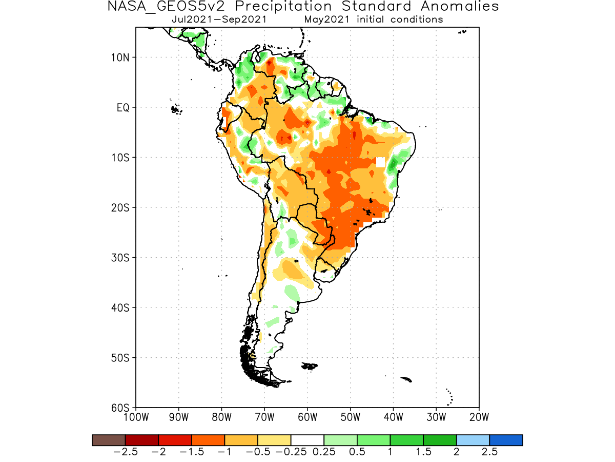How will winter 2021 be in Brazil?
According to NASA/NOAA forecasts, much of the season will be drier than normal.
Climate trends for the southern region
The southern region, especially Santa Catarina and Paraná, will be affected by the below-average preference, as winter is considered a wet season, responsible for the increase in the level of reservoirs.
In Rio Grande do Sul, there is also a forecast of below average rainfall, but exclusion will be more frequent, especially at the end of the season. Even with the below-average exclusion, winter crops should benefit from the drier climate. Despite the above-average temperature forecast, careful installation data will be with late frost that may appear until the end of August. Last year, a late frost in September decreased in a way that means a productivity of winter crops in Rio Grande do Sul. Taking into account the installation time at this time will be important to avoid late cold ahead.
Furthermore, specifically on the border between Rio Grande do Sul and Uruguay, rainfall will be more frequent than last winter, causing reservoirs used for rice irrigation to have a higher level than last year. This may eventually help to increase the installed area for the next harvest.
Climate trends for the Southeast and Midwest
The Southeast and Midwest regions already have a dry winter. And the trend is that it doesn't really rain much in the next few months. This means that crops such as sugarcane, wheat, corn, cotton, coffee and oranges result in their harvests proceeding at an accelerated pace. It is true that corn productivity should be low due to its late installation and prolonged drought in 2021. In addition, it will be exploited as cold waves with potential for frost, despite periods of neutrality the risk of the phenomenon appearing is greater.
Climate trends for the Northeast region
The Northeast region usually has heavy rains on the coast and the forest area, which often reach the wild. Although there is an above-average rainfall forecast, we are registering irregular protection. While Paraíba has high soil moisture, areas of Sergipe are experiencing water deficit. The scenario should not change much during the rainiest season of the year: there is even a forecast of accumulated levels, but there is no guarantee of good distribution.
Climate trends for the North region
Finally, in the North Region, what has been attracting attention is the high level of Amazonian rivers due to heavy rain observed in the summer. In winter, a separation will still be intense over Amapá and Roraima, but much of the North Region is going through its driest period. In Roraima, on the contrary, the middle of the year is the rainiest period, beneficial for the development of rice and maintenance of pastures.
 |  |
Forecast of standard deviation of protection and temperature in South America in winter 2021 (July-August-September). Source: NASA / NOAA




